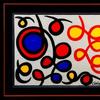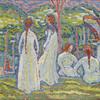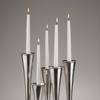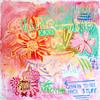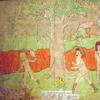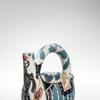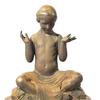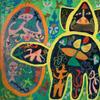New JMKAC Exhibition Considers Role of the Artist’s Studio in Creative Process
- SHEBOYGAN, Wisconsin
- /
- September 14, 2018
SHEBOYGAN, WI – From Picasso’s Paris ateliers to Bacon’s London studio to Warhol’s legendary New York Factory, and Pollack’s East Hampton barn, the artist’s studio has always been an elusive place of myth, mystery, and contradiction. A new exhibition opening this fall at the John Michael Kohler Arts Center (JMKAC) will explore the role of the artist’s studio. Through site-specific installations that shed light on the creative process, Makeshift, on view from September 23, 2018 – March 3, 2019, will examine the influence and function of the studio in contemporary art practices.
Organized by guest curator Michelle Grabner, Makeshift will feature the work of seven U.S.-based artists: Trenton Doyle Hancock, Jessica Jackson Hutchins, Brad Kahlhammer, Odili Donald Odita, Barbara Rossi, Greg Smith, and Alison Elizabeth Taylor.
The exhibition is part of the Arts Center’s Live/Work series, which comprises four exhibitions considering the influence and function of the most important of artist-built environments – the artist’s studio. Makeshift will look at the environment, tools, artists’ collections, and sources that fuel the process of creating the completed artworks on view. The three accompanying exhibitions are also on view with newly commissioned installations by Garry and Peggy Noland, Joel Otterson, and Virgil Marti.
The artists in Makeshift have all produced new work for the exhibition.
- Trenton Doyle Hancock constructs fantastical narratives, pulling from his personal experience, art historical references, and myriad pop culture references, resulting in a complex amalgamation of characters and plots possessing universal concepts of good and evil and all the grey in between. His Houston studio is filled with items from thrift shops that find their way into his work.
- Jessica Jackson Hutchins works to refigure an intimate engagement with materiality, form and the vernacular. She encrusts found upholstery furniture with collage, ceramics, and papier-mâché, creating dynamic sculptural installations that are hybrid juxtapositions of the readymade and the handmade. Her Portland, Oregon, studio houses a great variety of items waiting to be transformed.
- Brad Kahlhammer examines his Native American identity in a range of media from sculpture and painting to performance and music to explore what he refers to as the “third place”—a meeting point of two opposing personal histories. His New York studio is a menagerie of taxidermy animals and fishing lures juxtaposed with speakers and musical equipment.
- Odili Donald Odita is an abstract painter whose work explores color in both the figurative historical context and in the sociopolitical sense. A master of color and design, he analytically develops architectural-scaled wall paintings combining modernism with traditional Nigerian textile patterns. He uses his work to address the human condition through pattern, structure and design as well as for its possibility to trigger memory. His studio is based in Philadelphia.
- Barbara Rossi is one of the original Chicago Imagists, a group in the 1960s and 70s that turned to representational art. Haunting and distorted, Rossi’s images continue her longtime psychological investigations in identifying naturally occurring human features in found elements. She is known for meticulously rendered drawings and cartoonish paintings. She makes reverse paintings on Plexiglas that reference lowbrow and outsider art as well as a personal vernacular. Her studio is located in Berwyn, Illinois.
- Greg Smith, a multidisciplinary artist with a PhD in physics from Harvard, sets out to record the American landscape through absurdist installation, sculpture and video. His studio is located in Brooklyn, New York.
- Alison Elizabeth Taylor has become well-known for reinvigorating the Renaissance craft of marquetry, or intarsia wood inlay. After working within the boundaries of the limited palette afforded by natural woods, Taylor now mashes marquetry and paint in unprecedented ways, creating a new perspective on painting. Her studio is located in Brooklyn, New York.
“Makeshift will highlight how contemporary artists work and how they conceptualize and organize their studios to create an environment that’s conducive to improvisation, imagination, and inspiration,” said Sam Gappmayer, director of the John Michael Kohler Arts Center. “This concept is intrinsic to the mission of JMKAC’s ongoing dedication to supporting artists and artist environments.”
“We initiated this collaborative curatorial model last year, bringing in experts to expand the idea of the art environment,” said Karen Patterson, lead curator at JMKAC. “Michelle Grabner, who co-edited the book The Studio Reader: On the Space of Artists, which upended the conception of the artist’s studio, was an ideal partner for us. With Makeshift, she takes this opportunity to pull back the curtain from the art world to reveal the real activities behind artistic production. The exhibition’s diverse range of individual artists and artistic practices allows viewers the opportunity to assess similarities and differences among the artistic practices and physical artifacts on display.”
ABOUT GUEST CURATOR MICHELLE GRABNER
Michelle Grabner is a curator, artist, and writer based in Wisconsin. She is a professor of art at the School of the Art Institute of Chicago where she has taught for 20 years. In addition, Grabner has held teaching appointments at the University of Wisconsin-Madison; Cranbrook Academy of Art; Yale Norfolk; Milton Avery Graduate School of Arts – Bard College; Yale University School of Art; and Skowhegan School of Painting and Sculpture, Maine.
Grabner co-curated the 2014 Whitney Biennial and curated the 2016 Portland Biennial. In 2010, Mary Jane Jacob and Grabner co-edited The Studio Reader, published by the University of Chicago Press. Grabner is represented by James Cohan Gallery in NYC; Green Gallery, Milwaukee; Gallery 16, San Francisco; Rocket Gallery, London; and Anne Mosseri-Marlio Galerie, Basel. She and her husband, Brad Killam, founded The Suburban in 1999 in Oak Park, IL, hosting a range of international contemporary art. After 16 years in the Chicago vicinity, The Suburban began programming exhibitions in a two storefronts located in Milwaukee, Wisconsin. In 2009, Grabner and Killam opened The Poor Farm in rural Wisconsin. She is the artistic director of FRONT International: Cleveland Triennial for Contemporary Art, on view through September 30, 2018.
The Live/Work series is supported in part by a grant from the Wisconsin Arts Board with funds from the State of Wisconsin and the National Endowment for the Arts. Funding was also provided by the Kohler Trust for the Arts and Education, Kohler Foundation, Inc., and the Frederic Cornell Kohler Charitable Trust.
ABOUT THE JOHN MICHAEL KOHLER ARTS CENTER
The John Michael Kohler Arts Center located north of Milwaukee in Sheboygan, Wisconsin, was founded in 1967. It is dedicated to making innovative arts programming accessible to a broad audience that ranges from artists and academics to families and youth of all ages. Central to its mission is promoting understanding and appreciation of the work of self-taught and contemporary artists through original exhibitions, commissioned works of art, performing arts programs, and community arts initiatives. Since the 1970s, JMKAC has preserved, studied, and exhibited works by art-environment builders and has earned a worldwide reputation for its work in this area. Artist-built environments involve an individual significantly transforming their surroundings—for example, their home or yard—into an exceptional, multifaceted work of art.
The Arts Center’s downtown Sheboygan facility includes eight galleries, two performance spaces, a café, a retail shop, and a drop-in art-making studio. Among its program offerings are community arts projects; artist residencies; presentations of dance, film, and music; a free weekly summer concert series; classes and workshops; an onsite arts-based preschool program; and approximately twelve originally curated exhibitions of the work of self-taught and contemporary artists annually. The John Michael Kohler Arts Center also administers the renowned Arts/Industry residency program, which is hosted by Kohler Co. For more information please visit www.jmkac.org.
Contact:
Pat DuCheneJohn Michael Kohler Arts Center
920-694-4525
pduchene@jmkac.org



